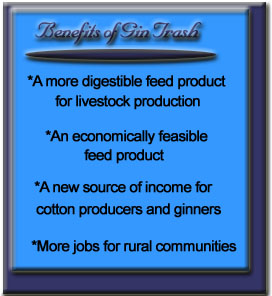|
Finding
a New Use for a Once
Disposable Product |
||||
| by Walker Wallace | ||||
|
|
||||
| Finally,
there may be something we can do with all of the gin trash Texas cotton
producers dispose of each year. Researchers atTexas Tech University are
in the process of determining the benefits of value-added cotton products
in animal feeds. The Texas Tech department of agricultural and applied economics is jointly researching with the department of animal science and food technology to design new formulations and develop technology that will enable the economical production of feed products made from cotton by-products that are usually disposed of after ginning. Each year over 1.2 million tons of cotton gin trash is produced in Texas. The cost to dispose of this trash is almost $2 million. The  current project at Tech is examining the technical and economic feasibility
of using an extrusion process to produce a value-added feed from raw gin
trash. A pilot extrusion process is currently underway at the USDA Gin Lab
in Lubbock.
current project at Tech is examining the technical and economic feasibility
of using an extrusion process to produce a value-added feed from raw gin
trash. A pilot extrusion process is currently underway at the USDA Gin Lab
in Lubbock. Economic cost analysis will be used to determine the cost structure for a prototype system. The system includes the use of an Insta-Dry extruder, which produces gin trash feed products. The main goal is to decide if the nutritional value of the feed will be high enough to justify its production. The research will try to increase the usage of gin trash in commercial production. According to C. Reed Richardson, professor in the animal science and food technology department, the main problem is getting the producers to use this product. "Producers are reluctant to do something that is uncommon," Richardson said. "It might be cheaper, but is not what they are used to doing." Producers are also afraid of driving the prices of this feed product up because of demand. Also, researchers will determine if a business enterprise involved in processing gin trash into livestock feed will quantify the profitability and financial risk of the enterprise. The research has many potential benefits. These include higher revenue for cotton producers and ginners, a more digestible roughage ingredient for livestock producers and a value-added enterprise that creates more jobs for rural communities. Researchers are also concerned about price competion with other feed products. "If people were to buy gin trash feed products at low prices it could affect the cost of other feeds such as alfalfa hay," Richardson said. Richardson said the product is good because it is produced nine months out of the year and helps ranchers replace grass in the summer. A current cost analysis is 90 percent complete on a dry-extrusion plant and discussion for an increase in funding on gin trash products. Current funding on the project is by Cotton Inc. and the College of Agricultural Sciences and Natural Resources at Texas Tech University. With this research, cotton producers will lower their costs of disposal and increase their revenues by selling something we once called trash. |
||||